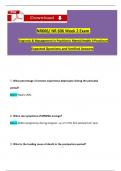Exam (elaborations)
NUR 2063 / NUR2063: Essentials of Pathophysiology Final Exam Review Study Guide (Latest 2023/2024) Rasmussen Pathophysiology Final Study Guide
- Institution
- Rasmussen College
NUR 2063 / NUR2063: Essentials of Pathophysiology Final Exam Review Study Guide (Latest 2023/2024) Rasmussen Pathophysiology Final Study Guide Patho Section 1 Cell & Tissue Function/Dysfunction Atrophy: decrease in size of cells. Hypertrophy: increase in cell size. Hyperplasia: increase in ...
[Show more]












